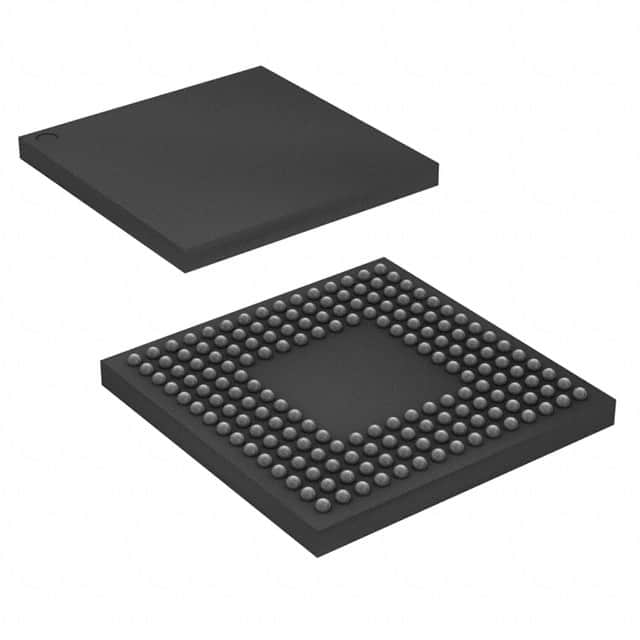MB9BF504RBPMC-G-JNE2
Basic Information Overview
- Category: Microcontroller
- Use: Embedded systems, IoT devices
- Characteristics: High-performance, low-power consumption, integrated peripherals
- Package: LQFP (Low-profile Quad Flat Package)
- Essence: Control and manage various electronic components in a system
- Packaging/Quantity: Tray packaging, 250 units per tray
Specifications
- Architecture: ARM Cortex-M4
- Clock Speed: Up to 120 MHz
- Flash Memory: 512 KB
- RAM: 64 KB
- Operating Voltage: 2.7V - 3.6V
- Operating Temperature: -40°C to +85°C
- Communication Interfaces: UART, SPI, I2C, CAN
- Analog-to-Digital Converter (ADC): 12-bit, 16 channels
- Timers: 16-bit, 32-bit
- PWM Channels: 8
- GPIO Pins: 80
Detailed Pin Configuration
The MB9BF504RBPMC-G-JNE2 microcontroller has a total of 100 pins. The pin configuration is as follows:
- Port A: PA0 to PA15
- Port B: PB0 to PB15
- Port C: PC0 to PC15
- Port D: PD0 to PD15
- Port E: PE0 to PE15
- Port F: PF0 to PF15
- Port G: PG0 to PG15
- Port H: PH0 to PH15
- Port J: PJ0 to PJ15
Functional Features
- High-performance ARM Cortex-M4 core for efficient processing
- Low-power consumption for extended battery life
- Integrated peripherals such as UART, SPI, I2C, and CAN for communication
- Analog-to-Digital Converter (ADC) for precise analog signal measurements
- Timers and PWM channels for accurate timing and control
- GPIO pins for interfacing with external devices
Advantages and Disadvantages
Advantages: - High-performance processing capabilities - Low-power consumption for energy-efficient applications - Integrated peripherals reduce the need for additional components - Ample flash memory and RAM for storing and executing code - Wide operating temperature range for versatile usage
Disadvantages: - Limited number of GPIO pins may restrict the number of external devices that can be connected - Higher cost compared to simpler microcontrollers with fewer features
Working Principles
The MB9BF504RBPMC-G-JNE2 microcontroller operates based on the ARM Cortex-M4 architecture. It executes instructions stored in its flash memory, utilizing the integrated peripherals and resources to control and manage various electronic components in a system. The microcontroller communicates with external devices through its communication interfaces, reads analog signals using the ADC, and generates precise timing and control signals using timers and PWM channels.
Detailed Application Field Plans
The MB9BF504RBPMC-G-JNE2 microcontroller finds applications in various fields, including: 1. Industrial automation: Controlling machinery and equipment in manufacturing processes. 2. Home automation: Managing smart home devices such as lighting, HVAC systems, and security systems. 3. Automotive electronics: Controlling vehicle subsystems like engine management, infotainment systems, and driver assistance systems. 4. Internet of Things (IoT): Enabling connectivity and control in IoT devices such as smart sensors, wearables, and home appliances. 5. Consumer electronics: Powering devices like gaming consoles, audio systems, and home entertainment systems.
Detailed and Complete Alternative Models
- MB9BFD10T: Similar features but with higher flash memory capacity (1 MB).
- MB9BFD20T: Similar features but with higher flash memory capacity (2 MB).
- MB9BFD30T: Similar features but with higher flash memory capacity (4 MB).
- MB9BFD40T: Similar features but with higher flash memory capacity (8 MB).
- MB9BFD50T: Similar features but with higher flash memory capacity (16 MB).
These alternative models provide options for different memory requirements while maintaining similar functionality and characteristics.
Word count: 529 words
Lista 10 Vanliga frågor och svar relaterade till tillämpningen av MB9BF504RBPMC-G-JNE2 i tekniska lösningar
Sure! Here are 10 common questions and answers related to the application of MB9BF504RBPMC-G-JNE2 in technical solutions:
Question: What is the MB9BF504RBPMC-G-JNE2 microcontroller used for?
Answer: The MB9BF504RBPMC-G-JNE2 microcontroller is commonly used in various technical solutions, such as industrial automation, consumer electronics, and automotive applications.Question: What is the operating voltage range of the MB9BF504RBPMC-G-JNE2?
Answer: The operating voltage range of the MB9BF504RBPMC-G-JNE2 is typically between 2.7V and 5.5V.Question: How many GPIO pins does the MB9BF504RBPMC-G-JNE2 have?
Answer: The MB9BF504RBPMC-G-JNE2 microcontroller has a total of 48 general-purpose input/output (GPIO) pins.Question: Can the MB9BF504RBPMC-G-JNE2 support communication protocols like UART, SPI, and I2C?
Answer: Yes, the MB9BF504RBPMC-G-JNE2 microcontroller supports various communication protocols, including UART, SPI, and I2C.Question: What is the maximum clock frequency of the MB9BF504RBPMC-G-JNE2?
Answer: The MB9BF504RBPMC-G-JNE2 can operate at a maximum clock frequency of up to 80 MHz.Question: Does the MB9BF504RBPMC-G-JNE2 have built-in analog-to-digital converters (ADC)?
Answer: Yes, the MB9BF504RBPMC-G-JNE2 microcontroller features a built-in 12-bit analog-to-digital converter (ADC).Question: Can the MB9BF504RBPMC-G-JNE2 be programmed using C/C++?
Answer: Yes, the MB9BF504RBPMC-G-JNE2 can be programmed using popular programming languages like C and C++.Question: What is the flash memory size of the MB9BF504RBPMC-G-JNE2?
Answer: The MB9BF504RBPMC-G-JNE2 microcontroller has a flash memory size of 512 KB.Question: Does the MB9BF504RBPMC-G-JNE2 support real-time operating systems (RTOS)?
Answer: Yes, the MB9BF504RBPMC-G-JNE2 is compatible with various real-time operating systems (RTOS) for more advanced applications.Question: Is the MB9BF504RBPMC-G-JNE2 suitable for low-power applications?
Answer: Yes, the MB9BF504RBPMC-G-JNE2 microcontroller is designed to be power-efficient, making it suitable for low-power applications where energy consumption is a concern.
Please note that the answers provided here are general and may vary depending on specific implementation details and requirements.


